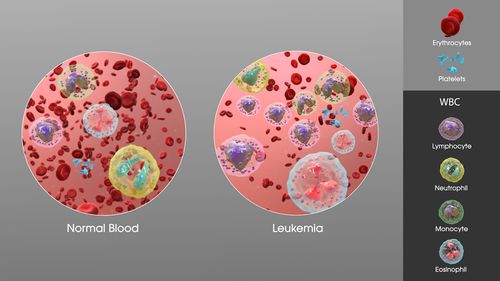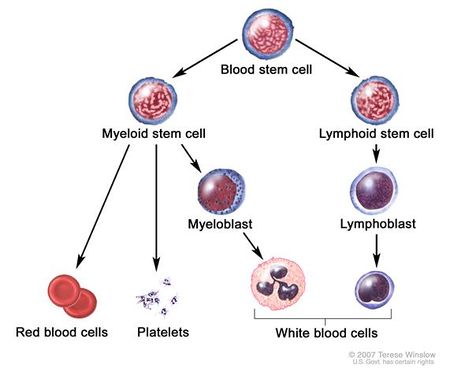Leukemia: Difference between revisions
No edit summary |
No edit summary |
||
| Line 8: | Line 8: | ||
</div> | </div> | ||
== Introduction == | == Introduction == | ||
Leukemia is a group of blood-related cancers that affect white blood cell replication in the bone marrow. The abnormal cells crowd out the healthy cells, which affects their ability to fight infection and impedes the production of blood cells.<ref>Very well health [https://www.verywellhealth.com/leukemia-overview-514157 Leukemia] Available from:https://www.verywellhealth.com/leukemia-overview-514157 (last accessed 16.7.2020)</ref> | [[File:Leukemia- SAG.jpg|right|frameless|500x500px]] | ||
Leukemia is a group of blood-related cancers that affect white [[blood]] cell replication in the [[bone]] marrow. The abnormal cells crowd out the healthy cells, which affects their ability to fight infection and impedes the production of blood cells.<ref name=":0">Very well health [https://www.verywellhealth.com/leukemia-overview-514157 Leukemia] Available from:https://www.verywellhealth.com/leukemia-overview-514157 (last accessed 16.7.2020)</ref> | |||
Leukemia is actually hundreds of different diseases on a molecular level, with no two leukemias being exactly alike. | |||
Image at R: 3D Medical Animation still showing an increase in white blood cells of a person suffering from Leukemia. | |||
== Pathophysiology == | == Pathophysiology == | ||
| Line 14: | Line 19: | ||
In leukaemia, due to the immature cells or some defect in the cells of the bone marrow, the abnormal and functionless WBC are produced which are unable to fight against the infection and defend the body against foreign substances. | In leukaemia, due to the immature cells or some defect in the cells of the bone marrow, the abnormal and functionless WBC are produced which are unable to fight against the infection and defend the body against foreign substances. | ||
[[File:Multiple Myeloma pic.jpg|right|frameless|450x450px]] | |||
Also, they obstruct the production of other blood cells by dividing quickly and crowding among normal cells. | |||
Myelogenous vs. Lymphocytic Leukemia | |||
All of the blood cells derive from pluripotential stem cells in the bone marrow thanks to a process called hematopoiesis. These cells differentiate into either | |||
# Myeloid cells (the myeloid cell line). Myeloid cells differentiate into red blood cells, platelets, and the type of cells found in myeloid leukemia: neutrophils, monocytes, and more. | |||
# Lymphoid cells differentiate into either B lymphocytes (B cells) or T lymphocytes (T cells), and lymphocytic leukemias may begin in either of these cell types. | |||
Acute or Chronic | |||
# | # Acute leukemias arise from immature cells in the bone marrow (myeloblasts or lymphoblasts). These cells do not function like fully mature ones in fighting off infections. In addition, they often crowd the bone marrow, preventing the production of other blood cells such as red blood cells, other white blood cells, and platelets. Without treatment, acute leukemias often progress very rapidly. | ||
# Chronic leukemia arises from mature, but abnormal white blood cells. These cancers grow much more slowly and may be discovered accidentally when a blood count is done for another reason<ref name=":0" />.<ref>Boldsky [https://www.boldsky.com/health/disorders-cure/leukaemia-causes-types-symptoms-complications-treatment-prevention-130098.html Leukemia] Available from:https://www.boldsky.com/health/disorders-cure/leukaemia-causes-types-symptoms-complications-treatment-prevention-130098.html (last accessed 16.7.2020)</ref> | |||
== | == Types == | ||
The major types of leukemia are: | |||
# [[Acute Lymphoblastic Leukemia|Acute lymphocytic leukemia]] (ALL). This is the most common type of leukemia in young children. ALL can also occur in adults. | |||
# [[Acute Myeloid Leukemia|Acute myelogenous leukemia]] (AML). AML is a common type of leukemia. It occurs in children and adults. AML is the most common type of acute leukemia in adults. | |||
# Chronic lymphocytic leukemia (CLL). With CLL, the most common chronic adult leukemia, you may feel well for years without needing treatment. | |||
# Chronic myelogenous leukemia (CML). This type of leukemia mainly affects adults. A person with CML may have few or no symptoms for months or years before entering a phase in which the leukemia cells grow more quickly. | |||
* Other types. Other, rarer types of leukemia exist, including hairy cell leukemia, myelodysplastic syndromes and myeloproliferative disorders<ref>Mayo clinic [https://www.mayoclinic.org/diseases-conditions/leukemia/symptoms-causes/syc-20374373 Leukemia] Available from:https://www.mayoclinic.org/diseases-conditions/leukemia/symptoms-causes/syc-20374373 (last accessed 16.7.2020)</ref>. | |||
== Sub Heading 3 == | == Sub Heading 3 == | ||
Revision as of 01:16, 16 July 2020
This article or area is currently under construction and may only be partially complete. Please come back soon to see the finished work! (16/07/2020)
Original Editor - User:Lucinda hampton
Top Contributors - Lucinda hampton, Kim Jackson, Vidya Acharya, Kapil Narale and Aya Alhindi
Introduction[edit | edit source]
Leukemia is a group of blood-related cancers that affect white blood cell replication in the bone marrow. The abnormal cells crowd out the healthy cells, which affects their ability to fight infection and impedes the production of blood cells.[1]
Leukemia is actually hundreds of different diseases on a molecular level, with no two leukemias being exactly alike.
Image at R: 3D Medical Animation still showing an increase in white blood cells of a person suffering from Leukemia.
Pathophysiology[edit | edit source]
Bone marrow is responsible for the making of red blood cells (RBC), white blood cells (WBC) and platelets.
In leukaemia, due to the immature cells or some defect in the cells of the bone marrow, the abnormal and functionless WBC are produced which are unable to fight against the infection and defend the body against foreign substances.
Also, they obstruct the production of other blood cells by dividing quickly and crowding among normal cells.
Myelogenous vs. Lymphocytic Leukemia
All of the blood cells derive from pluripotential stem cells in the bone marrow thanks to a process called hematopoiesis. These cells differentiate into either
- Myeloid cells (the myeloid cell line). Myeloid cells differentiate into red blood cells, platelets, and the type of cells found in myeloid leukemia: neutrophils, monocytes, and more.
- Lymphoid cells differentiate into either B lymphocytes (B cells) or T lymphocytes (T cells), and lymphocytic leukemias may begin in either of these cell types.
Acute or Chronic
- Acute leukemias arise from immature cells in the bone marrow (myeloblasts or lymphoblasts). These cells do not function like fully mature ones in fighting off infections. In addition, they often crowd the bone marrow, preventing the production of other blood cells such as red blood cells, other white blood cells, and platelets. Without treatment, acute leukemias often progress very rapidly.
- Chronic leukemia arises from mature, but abnormal white blood cells. These cancers grow much more slowly and may be discovered accidentally when a blood count is done for another reason[1].[2]
Types[edit | edit source]
The major types of leukemia are:
- Acute lymphocytic leukemia (ALL). This is the most common type of leukemia in young children. ALL can also occur in adults.
- Acute myelogenous leukemia (AML). AML is a common type of leukemia. It occurs in children and adults. AML is the most common type of acute leukemia in adults.
- Chronic lymphocytic leukemia (CLL). With CLL, the most common chronic adult leukemia, you may feel well for years without needing treatment.
- Chronic myelogenous leukemia (CML). This type of leukemia mainly affects adults. A person with CML may have few or no symptoms for months or years before entering a phase in which the leukemia cells grow more quickly.
- Other types. Other, rarer types of leukemia exist, including hairy cell leukemia, myelodysplastic syndromes and myeloproliferative disorders[3].
Sub Heading 3[edit | edit source]
Resources[edit | edit source]
- bulleted list
- x
or
- numbered list
- x
References[edit | edit source]
- ↑ 1.0 1.1 Very well health Leukemia Available from:https://www.verywellhealth.com/leukemia-overview-514157 (last accessed 16.7.2020)
- ↑ Boldsky Leukemia Available from:https://www.boldsky.com/health/disorders-cure/leukaemia-causes-types-symptoms-complications-treatment-prevention-130098.html (last accessed 16.7.2020)
- ↑ Mayo clinic Leukemia Available from:https://www.mayoclinic.org/diseases-conditions/leukemia/symptoms-causes/syc-20374373 (last accessed 16.7.2020)








